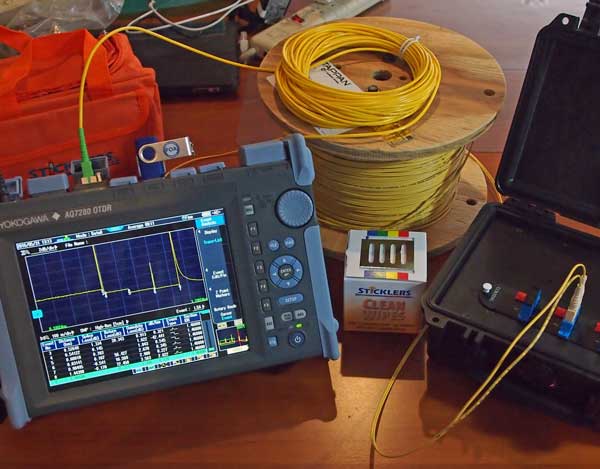Modern Fibre Testing Equipment for Field and Field Use
Wiki Article
Important Functions to Seek in Optical Fiber Screening Equipment
When examining optical fibre screening equipment, a number of important attributes require cautious factor to consider to ensure ideal efficiency and dependability. Compatibility with existing industry standards boosts performance, while advanced dimension abilities, including TDR and OTDR screening, offer essential insights right into network integrity. Recognizing these attributes will drop light on just how to select the best tools for your certain demands.Precision and Precision
Precision and precision are critical specifications in the evaluation of optical fiber testing tools. These two attributes make certain that measurements show truth performance of fibre optic systems, which is essential for effective network setup, maintenance, and troubleshooting. Precision refers to the nearness of a gauged value to the real value, while accuracy represents the repeatability of measurements under the same conditions.When selecting optical fibre screening tools, it is important to consider instruments that supply high precision and precision to minimize errors in data interpretation. Tools such as optical time-domain reflectometers (OTDRs) and power meters must have calibration mechanisms to guarantee regular efficiency over time. Furthermore, the specs supplied by suppliers need to detail the equipment's dimension unpredictability, which directly impacts the integrity of examination results.
Furthermore, the performance of optical fibre testing equipment can be influenced by environmental variables, such as temperature level and humidity. Picking tools made to mitigate these variables will certainly boost dimension integrity. To conclude, buying optical fibre screening tools with robust accuracy and accuracy functions is fundamental for keeping optimum network performance and guaranteeing the integrity of fiber optic interactions.

User-Friendly User Interface
The efficiency of optical fiber testing tools is not solely established by its accuracy and accuracy; an user-friendly user interface plays a significant function in enhancing operational performance. A well-designed interface streamlines the interaction between the technician and the devices, permitting a more user-friendly understanding of intricate functions.Trick features of an easy to use user interface consist of clear navigation menus, rational formats, and conveniently accessible controls. These aspects make it possible for technicians to carry out examinations promptly without extensive training, decreasing the probability of customer mistake - ofda. Moreover, visual signs such as development bars, signals, and graphical representations of data can considerably improve the individual experience by giving prompt responses on the screening procedure.
In addition, personalized setups can better simplify procedures by permitting customers to change specifications according to certain testing demands. This adaptability not only conserves time yet additionally makes sure that the devices meets diverse application demands.
Incorporating aid functions, such as tooltips and comprehensive handbooks, into the user interface can additionally empower customers, promoting self-sufficiency and self-confidence in operating the devices. Ultimately, a straightforward user interface is important for making the most of the possibility of optical fibre screening devices, bring about much more reliable and effective screening end results.
Portability and Durability
Mobility and toughness are essential qualities of optical fiber testing devices, making certain that it can withstand the rigors of different settings while continuing to be easy to transport. Professionals often operate in diverse setups, from telecoms centers to remote installments, making it vital that screening devices are light-weight and portable (ofda). Tools designed with portability in mind usually features ergonomic manages and instances that promote easy activity, hence boosting functional performance on-siteDurability is equally important, as optical fibre testing tools is often exposed to harsh conditions, consisting of temperature level variations, dampness, and physical influences. Tools built with sturdy products such as enhanced plastics or steel real estates are better suited for these environments, minimizing the threat of damages during use and transport. In addition, tools with water and dust resistance ratings, such as IP ratings, makes certain trusted efficiency in difficult conditions.
Compatibility With Requirements
Making certain compatibility with market standards is vital for optical fiber testing equipment, as it straight affects the reliability and legitimacy of examination results. Optical fiber networks go through stringent efficiency requirements established by numerous organizations, consisting of the Telecoms Market Association (TIA) and the International Electrotechnical Payment (IEC) Checking equipment has to abide by these criteria to guarantee that measurements correspond and comparable throughout different systems and settings.
When selecting optical fiber testing tools, users need to confirm that the tool satisfies relevant criteria relevant to their details application, such as those associated to depletion, bandwidth, and crosstalk. Tools that ofda is compliant with well established standards not only aids in achieving precise outcomes however additionally helps with interoperability amongst devices from different makers.
In addition, compatibility with standards makes sure that the tools can be used in regulative conformity circumstances, which is crucial for jobs in fields such as telecommunications, aerospace, and armed forces applications. Investing in optical fibre testing devices that lines up with existing sector criteria is a fundamental aspect of maintaining quality assurance and accomplishing ideal network performance.
Advanced Measurement Abilities
Advanced measurement abilities are a defining function of modern-day optical fiber screening devices, enabling comprehensive evaluation of network efficiency. These abilities ensure that specialists can assess important parameters such as signal loss, diffusion, and transmission capacity, which are essential for maintaining optimum interaction performance.One secret element is the ability to perform time-domain reflectometry (TDR) and optical time-domain reflectometry (OTDR) examinations. These methods allow users to recognize mistakes, determine the length of fibers, and figure out the location of defects with impressive accuracy - ofda. Additionally, advanced tools commonly includes the capacity to determine optical power levels, aiding to examine the overall wellness of the network and make sure compliance with the called for specs.
In addition, some screening devices use innovative formulas for real-time analysis, allowing quicker medical diagnosis and troubleshooting. In verdict, spending in optical fibre testing equipment with sophisticated dimension capacities is essential for ensuring network dependability and efficiency in today's requiring telecoms landscape.
Verdict

Report this wiki page